
The Stones of Babylon
"And they will not take from you even a stone for a corner
Nor a stone for foundations,
But you will be desolate forever," declares the LORD.
Jeremiah 51:26
THIS PROPHECY HAS NEVER BEEN FULFILLED!
(therefore, Babylon must Rise Again)
PHOTOGRAPHIC PROOF below
return to BABYLON REBUILT main article

Recycled Building Stone at Babylon
LEFT: Photo of actual Babylon-building-stone (with official documentation from the 1884 "Wolfe Expedition") taken from the thousands upon thousands of Babylon-"bricks" which have been used over centuries to build the houses and buildings of the city of Hillah, which was founded upon the ruins of Babylon in 1101 AD.
Note the ancient Babylonian text inscribed on the Stone.
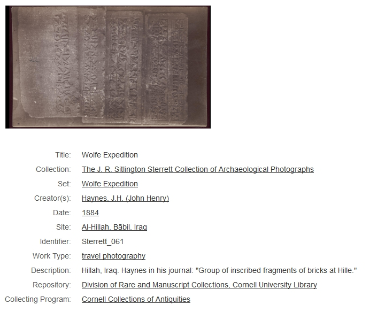
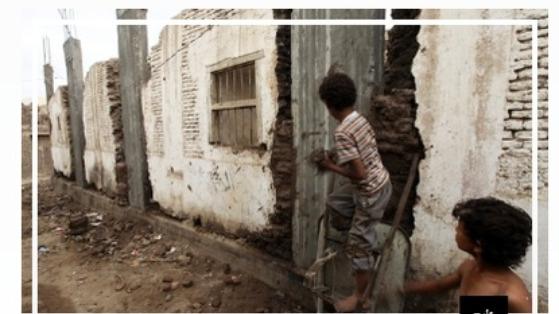
Houses built largely from Babylon's reused "Stones"
ABOVE: Typical house at Hillah.
[Hillah] was built (c.1100) largely of material (STONES/"bricks") taken from the nearby ruins of ancient Babylon.
https://www.encyclopedia.com/places/asia/iraq-political-geography/al-hillah

Babylon Stones typically uncovered in home demolition
ABOVE: A house at Hillah revealing the Stones ("bricks") extracted from the Babylon-ruins from which it was constructed.
These Stones become apparent in many of the older buildings that are torn down to be replaced by newer construction.
https://www.encyclopedia.com/places/asia/iraq-political-geography/al-hillah
Babylon "stone-quarry"
LEFT: An early twentieth-century postcard making mention of the pillaging of Babylon's Stones--a fact that had become obvious to the first Babylon explorers and archaeologists as far back as the 1700's.
Read the inscription at the bottom. It is a direct refutation that the prophecy below has ever been fulfilled.
"And they will not take from you even a stone for a corner, Nor a stone for foundations" Jeremiah 51:26
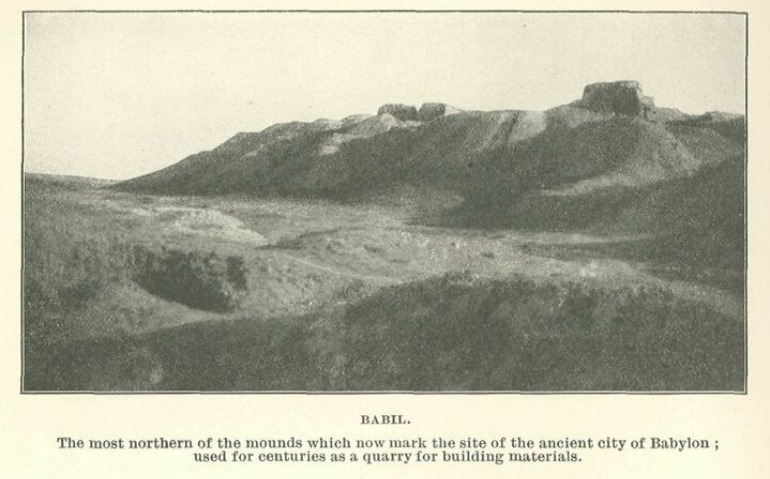
What's happening with Babylon-Stones today...

Babylon's Stones still reused today!
ABOVE: Look at archaeology-writer Andrew Lawler's words (in blue above) from his book "Babylon, Gate of the Gods." This is not a book found in Christian bookstores. Yet, follow the yellow lines on the graphic and note that--unknown to the writer--the wording corresponds precisely to Jeremiah's prophecy (in red) that "not a cornerstone or a foundation stone" will be taken from Babylon for reuse AFTER ITS FINAL FALL.
Has this prophecy been fulfilled yet?
No. Literally, "Concrete" evidence that Babylon must rise up again!
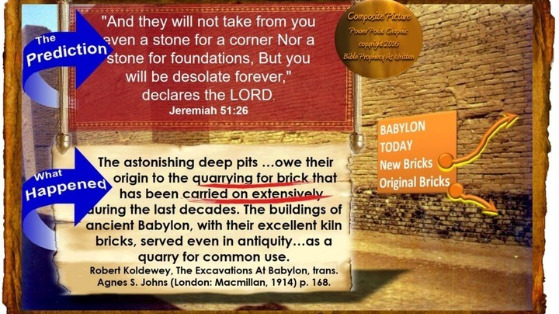
Babylon's ancient Stones supporting new buildings!
In the ABOVE picture we see the current rebuilt wall of Babylon sitting atop the original STONES ("bricks") of ancient Babylon. Don't be put off by the smallness of this current project.
“Do not despise the Beginning of Small Things” Zechariah 4:10
Keep in mind that Jerusalem as we know it today is a huge city that began by building the new city around the walls of "old Jerusalem." Today, the "old city" (Ottoman era walls, with "the deeper the older" sections all the way back to the City of David and beyond) is surrounded by the modern city which extends far beyond the old-walled Jerusalem.
Likewise, today the old Babylon of Chaldea (Iraq) archaeological city has spread way beyond its site by the recycling of its stones to spawn Hillah, one of Iraq's major cities. What province is Hillah the capital of? "BABIL".
LEFT: The Mound of Homera at Babylon.
This mound, one of several that mark the archaeological site of Babylon, has been shown to be, by Robert Koldewey's digs from 1898-1915, a chief source through the centuries of ancient Babylon "bricks" Stones, having been amassed in a giant pile of rubble from some of Babylon's demolished buildings and walls.
It has thus served as a "Quarry" for the recycling of Babylon's Stones for reuse in newer construction.
Note the extracted comments (LEFT) from Koldewey's book, The Excavations At Babylon (1914), about how Alexander The Great used this mound of Stones-"bricks" to do some of his own rebuilding projects at Babylon in the 4th century BC.
Babylon's ancient Stone bricks have been scavenged out of the ground and reused to testify that the "great city" will be Rebuilt and rise up again.
return to BABYLON REBUILT main article
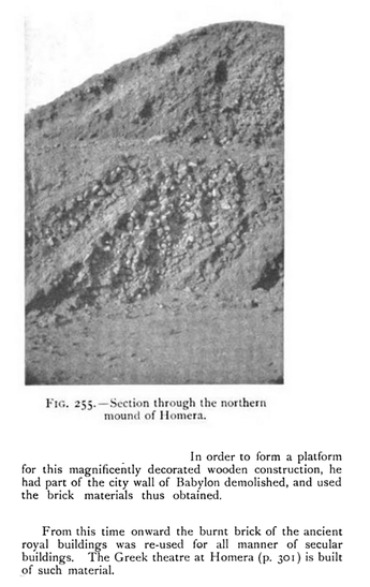
NOTES:
Andrew Lawler makes this reference to a photo (shown above) in his book, "Below, an Iraqi workcrew, digging down to the ancient brick foundations of Nebuchadrezzar's Babylon, to use these corner-stone foundations to "re-erect" Babylon's ancient walls and buildings…"
photo, cf. p. 51. Andrew Lawler. "Babylon, Gate of the Gods, 1800BC-AD 75." Smithsonian. Vol. 34 No. 3. June 2003. Washington, D.C.
"The little town of Hillah, near the site of Babylon, is built almost wholly of bricks taken from [the great palace of Nebuchadnezzar]. "
Easton’s Bible Dictionary, “Babylon”
" The astonishing deep pits and galleries that occur in places owe their origin to the quarrying for brick that has been carried on extensively during the last decades. The buildings of ancient Babylon, with their excellent kiln bricks, served even in antiquity, perhaps in Roman times, certainly in Parthian days, as a quarry for common use."
Robert Koldewey, The Excavations At Babylon, trans. Agnes S. Johns (London: Macmillan, 1914) p. 168.
Looters had been plundering the ancient site, about 85 miles south of Baghdad for centuries.
Babylon's future written in its ruins,
By Khalid al-Ansary, BABYLON, Iraq, Feb. 10, 2009 (Reuters)
As early as the 1780s visitors observed that the site had been looted.
http://www.jewishvirtuallibrary.org/jsource/judaica/ejud_0002_0003_0_01806.html
"[Seleucas Nicator] built Seleucia on the Tigris from the ruins of Babylon..."
R. Ludwigson, A Survey Of Bible Prophecy, Zondervan Publishing House, Grand Rapids, MI, 1951, p.34.
"The baked bricks from which the city's palaces had been built had disappeared. They had been extracted from within the walls over hundreds of years."
Joseph Chambers, A Palace For The Antichrist, 1996, [recording the author's personal visit to Babylon in 1992], New Leaf Press, Forest, AR, p.74.
Regarding Seleucia, William S. LaSor notes, "It was built largely with materials brought from Babylon, and its founding marks the end of Babylon's political significance.
Dr. J. Paul Tanner, Daniel: Introduction Archaeol. Rediscovery of Babylon
May 14, 2002 App. P.1, Ancient Babylon: From Gradual Demise To Archaeological Rediscovery
http://paultanner.org/English%20Docs/Daniel/Introductory/App%20P%20-%20Archaeological%20Backgrd.pdf
[Babylon's] finely baked bricks have been used for centuries to build other buildings in the vicinity. A large town within visible sight named Hillah is almost completely constructed of bricks with the name Nebuchadnezzar stamped in them.
Joseph Chambers, A Palace For The Antichrist, 1996, [recording the author's personal visit to Babylon in 1992], New Leaf Press, Forest, AR, p.31.
[Hillah] was built (c.1100) largely of material taken from the nearby ruins of ancient Babylon. It is a port and the main cereal market of the middle Euphrates area.
https://www.encyclopedia.com/places/asia/iraq-political-geography/al-hillah
"...the ruin of the buildings of Babylon has been mainly accelerated by the removal of the materials with which she was built, for the construction of other towns in the neghborhood..."
Benjamin Wills Newton, (quoting a letter to the author from a man from India who had visited Babylon) in Babylon: Its Revival And Final Desolation, Houlston & Wright, 1859, p. 44-45.
Pietro della Valle [in 1616 AD] correctly identified the site of Bâbil ...He noted that villagers were mining and selling Babylon's kiln-fired bricks...
Dr. J. Paul Tanner, Daniel: Introduction Archaeol. Rediscovery of Babylon
May 14, 2002 App. P.1, Ancient Babylon: From Gradual Demise To Archaeological Rediscovery, http://paultanner.org/English%20Docs/Daniel/Introductory/App%20P%20-%20Archaeological%20Backgrd.pdf
During the years 1780 and 1790 Joseph de Beauchamp made visits to the ruins of Babylon and conducted what is believed to be the first minor excavations of the site...He collected inscribed bricks...For the abbé was told by the workmen who were employed to dig for bricks in the Hillah mound that they had found large, thick walls and rooms...[but the workers] simply wanted the hard, kiln-baked bricks...
Wellard, By the Waters of Babylon, quoted by Dr. J. Paul Tanner, Daniel: Introduction Archaeol. Rediscovery of Babylon, May 14, 2002 App. P.1, Ancient Babylon: From Gradual Demise To Archaeological Rediscovery, http://paultanner.org/English%20Docs/Daniel/Introductory/App%20P%20-%20Archaeological%20Backgrd.pdf
By the time of C. J. Rich [1811-12, 1817 AD], this practice of carting off the bricks had taken a heavy toll on the archaeological site. Regarding the mound of Amran which included Esagila [Temple of Babylonian Marduc], Rich wrote, ". . . the greatest supplies have been and are now constantly drawn from it, they appear still to be abundant. But the operation of extracting the bricks has caused great confusion... [ C. J. Rich made the first accurate plan of the site of Babylon (which was published in 1815) ].
Dr. J. Paul Tanner, Daniel: Introduction Archaeol. Rediscovery of Babylon, May 14, 2002 App. P.1, Ancient Babylon: From Gradual Demise To Archaeological Rediscovery, http://paultanner.org/English%20Docs/Daniel/Introductory/App%20P%20-%20Archaeological%20Backgrd.pdf
Early explorer-archaeologist C. J. Rich writes, "...Babylon was visited by the well-known traveller, Olivier, who thus describes it...'in every direction the earth has evidently been dug into. Here the Arabs have for more than twelve centuries been occupied in digging and carrying away the bricks, with which chiefly Coufa, Bagdad, Mesjid, Ali, Mesjid Hussein, Hillah, and almost all the towns in the neighbourhood have been built.
Claudius James Rich, Esq., Narrative Of A Journey To The Site Of Babylon In 1811, edited by his widow, 1819, Duncan and Malcolm, Paternoster Row, London, Introduction xl.
"[In the latter part 1800's]...The plundering of the ruins of Babylon continued to increase; in addition to the baked bricks, the locals also took stone monuments..."
Dr. J. Paul Tanner, Daniel: Introduction Archaeol. Rediscovery of Babylon, May 14, 2002 App. P.1, Ancient Babylon: From Gradual Demise To Archaeological Rediscovery, http://paultanner.org/English%20Docs/Daniel/Introductory/App%20P%20-%20Archaeological%20Backgrd.pdf
Robert Koldewey, German archaeologist, carried out his archaeological work at Babylon [and reported].... A great quantity of the bricks had already been removed and used elsewhere for building material before the archaeologists even arrived....Koldewey’s excavations at Babylon ... stand as one of the great archaeological achievements of all time.
Dr. J. Paul Tanner, Daniel: Introduction Archaeol. Rediscovery of Babylon, May 14, 2002 App. P.1, Ancient Babylon: From Gradual Demise To Archaeological Rediscovery, http://paultanner.org/English%20Docs/Daniel/Introductory/App%20P%20-%20Archaeological%20Backgrd.pdf
...the ziggurat of Babylon, called Etemenanki...is now entirely in ruins, having for centuries been plundered for its bricks, which were used in other buildings.
Gonzalo Baez-Camargo, Archaeological Commentary On The Bible, 1984, Doubleday & Company, Garden City, NY, p. 9.
Hillah ["Amidst the heaps that marked the site of Babylon herself there rose the small town of Hillah", Layard's journal, 1853, p.428] may contain about eight or nine thousand inhabitants. ... The houses, chiefly built of bricks taken from the ruins of ancient Babylon ...
Discoveries among the Ruins of Nineveh and Babylon, p. 395.
Author: Austen H. Layard
NEW-YORK: G. P. PUTNAM & CO., 10 PARK PLACE. 1853.
http://www.gutenberg.org/files/39897/39897-h/39897-h.htm#fna_203
...[there is] part of a building which stood in the midst of old Babylon.
This ruin has for ages been the mine from which the builders of cities rising after the fall of Babylon have obtained their materials. To this day there are men who have no other trade than that of gathering bricks from this vast heap and taking them for sale to the neighboring towns and villages, and even to Baghdad. There is scarcely a house in Hillah which is not almost entirely built with them; and as the traveller passes through the narrow streets, he sees in the walls of every hovel a record of the glory and power of Nebuchadnezzar.
Discoveries among the Ruins of Nineveh and Babylon, p. 412.
Author: Austen H. Layard
NEW-YORK: G. P. PUTNAM & CO., 10 PARK PLACE. 1853.
http://www.gutenberg.org/files/39897/39897-h/39897-h.htm#fna_203
Al Hillah, city (1965 pop. 84,717)...provincial capital of central Iraq on a branch of the Euphrates River. It was built (c. 1100) largely of material taken from the nearby ruins of ancient Babylon. It is a port and the main cereal market of the middle Euphrates area.
The New Columbia Encyclopedia, Columbia University Press, 1975, New York, p. 67.
"...millions and millions of bricks [Nebuchadnezzar] had made for his construction program--bricks so well made that not only in Persian but well into the Hellenistic period and even recent times they have been continually pilfered for use in other structures..."
Anton Gill, The Rise And Fall Of Babylon, Gateway Of The Gods, 2008, Metro Books, New York, NY, p. 105.
"For hundreds of years people living on the banks of the River Euphrates in Iraq had dug into the mounds of ancient Babylon for the hard baked bricks used in the old buildings. Most of the villages along that part of the river, and the town of Hillah, were largely built with Babylonian bricks. Yet, although the ruins were pillaged in this way, the city was so great that much remained...This great mass of mud-brick had been a rich quarry for the local brick-hunters."
Alan Millard, Treasures From Bible Times, 1985, Lion Publishing, Belleville, MI, p. 135, 137.
...many towns and cites have been built from the ruins of Babylon, among them Four Capital Cities, Seleucia, built by the Greeks; Ctesiphon, by the Parthians; Al Maiden, by the Persians; and Kufa, by the Caliphs. Hillah was entirely constructed from the debris, and even in the houses of Bagdad, Babylonian stamped bricks may be frequently noticed.
Clarence Larkin, Dispensational Truth, 1918, Rev. Clarence Larkin Est., Glenside, PA, p. 142.
Iraqi archaeologist Hai Katth Moussa said that during a massive reconstruction project in the early 1980s, Saddam began building a replica of the palace of Nebuchadnezzar II on top of the ruins of the ancient palace.
CNN WORLD--Inside the Middle East
http://www.cnn.com/2013/04/04/world/meast/iraq-babylon-tourism/
For centuries, people in the area saw Babylon as a source of solid bricks to take away to build homes in the city of Hilla and surrounding villages. Over time, townspeople removed an entire top layer of the Ishtar Gate and threw away the ornamental glazed blue bricks that were later reclaimed to make up part of the reconstructed gate in Berlin's Pergamon Museum.
In Iraq, A Race To Protect The Crumbling Bricks Of Ancient Babylon, A U.S.-funded conservation project is shoring up the brick walls of the ancient city. The hope is that Babylon will qualify for UNESCO World Heritage status.; Jane Arraf, Posted on November 24, 2018, Copyright 2019 NPR
https://www.houstonpublicmedia.org/npr/2018/11/24/669272204/in-iraq-a-race-to-protect-the-crumbling-bricks-of-ancient-babylon/
In the 19th Century, the ...Ishtar Gate of Babylon was stripped of its tiles and reconstructed in the Pergamon Museum in Berlin.
BBC, By Paul Cooper, 20 April 2018http://www.bbc.com/culture/story/20180419-saddam-disney-for-a-despot-how-dictators-exploit-ruins
The whole of the walls of the Southern Citadel have been pillaged by brick robbers even below the pavement...
Robert Koldewey, The Excavations At Babylon, translated by Agnes S. Johns, MacMillan and Co., Limited, St. Martin's Street, London, 1914, p.82.
[Procession Street paving block inscribed by Nebuchadnezzar] may have been brought from the neighbourhood of Hit or Anah...
Robert Koldewey, The Excavations At Babylon, translated by Agnes S. Johns, MacMillan and Co., Limited, St. Martin's Street, London, 1914, p.25.
Alexander the Great (331-323) set himself to prevent the decline of Babylon, which was then beginning, and to restore it to its former magnitude. The great tower of Etemenanki, the sactuary of Bel, and a marked feature of Babylon, was to have been rebuilt. The fallen masses were carried away, and the debris lies here in the mounds of Homera, but the king died before he could rebuild the tower.
From this time onward the burnt brick of the ancient royal buildings was re-used for all manner of secular buildings. The Greek theatre at Homera (p. 301) is built of such material. Thus the pillared buildings of Amran (p. 215 et seq.) and houses at Merkes, that are built of brick rubble, belong either to the Greek (331-139 B.C.) or the Parthian (139 B.C.-226 A.D.) periods...
Robert Koldewey, The Excavations At Babylon, translated by Agnes S. Johns, MacMillan and Co., Limited, St. Martin's Street, London, 1914, p.310.
In order to [erect a funeral pyre for Hephaestion, Alexander the Great] had part of the city wall of Babylon demolished, and used the brick materials thus obtained.
Robert Koldewey, The Excavations At Babylon, translated by Agnes S. Johns, MacMillan and Co., Limited, St. Martin's Street, London, 1914, p.311.
What is to be seen there [at the Etemenanki "Tower Of Babel"] at the present time--low banks round the deep trenches--is merely the result of modern digging by Arab brick robbers.
Robert Koldewey, The Excavations At Babylon, translated by Agnes S. Johns, MacMillan and Co., Limited, St. Martin's Street, London, 1914, p.309.
...the southern one [Mound of Homera Babylon building-stones] was used as the substructure for a theatre [Greek Theatre]...
Robert Koldewey, The Excavations At Babylon, translated by Agnes S. Johns, MacMillan and Co., Limited, St. Martin's Street, London, 1914, p.310.
...the site [Babylon] has been long mined for building materials on a commercial scale.
http://wikimapia.org/1857784/Babylon
Birth of Hillah: Built up upon Babylon STONES
In the 10th century, the town of Al Jami'ayn was founded on the eastern bank of the Euphrates. The location of that town is in modern-day Hillah now. In 1101 AD a new town was founded near Al Jami'ayn. Bricks were taken from Babylon to build houses and so Hillah expanded. During the 18th century, the town became an administrative center in the Ottoman Empire
https://www.wikiwand.com/en/Hillah
The following 3 accounts are quotations from C. J. Rich's highly regarded early work at Babylon in 1811.
"There are two paths near this ruin [the Kasr, i.e., Nebuchadnezzaer Palace], made by the workmen who carry down their bricks to the river side, whence they are transported by boats to Hillah."
Ancient Cities Of The World, The Great Cities Of The Ancient World, In their Glory and their Desolation, by Gheodore Alois Buckley, B. A., Geo. Routledge & Co., 2 Farringdon St., London, 1852, p. 30.
Accessed at: https://books.google.com/books?id=Xw6PQdAHvfcC&pg=PA30&lpg=PA30&dq=There+are+two+paths+near+this+ruin,+made+by+the+workmen+who+carry+down+their+bricks+to+the+river+side&source=bl&ots=WX0-HtDCyd&sig=ACfU3U3gQ0f-Vmw2naTAp7n2Wyry6YPf5Q&hl=en&sa=X&ved=2ahUKEwjNub_EzJ_kAhUogK0KHXBnAx8Q6AEwA3oECAoQAQ#v=onepage&q&f=false
[The successor to Alexander in the empire of the East, Seleucas Nicator] chose a site near [Babylon] on the banks of the Tigris, founded a new city, calling it Seleucia, after his own name, and partly constructing it of materials taken from Babylon.
Ancient Cities Of The World, The Great Cities Of The Ancient World, In their Glory and their Desolation, by Gheodore Alois Buckley, B. A., Geo. Routledge & Co., 2 Farringdon St., London, 1852, p. 25.
The most elevated part [of a massive Babylon mound] may be about fifty or sixty feet above the level of the plain; and it has been dug into for the purpose of obtaining bricks...the second grand heap of ruins...the most interesting part of the ruins of Babylon...in the eastern quarter: the bricks are of the finest description, and, notwithstanding this is the grand storehouse of them, and that the greatest supplies have been, and are now constantly drawn from it, they appear still to be abundant...a ravine, hollowed out by those who dig for bricks...
Ancient Cities Of The World, The Great Cities Of The Ancient World, In their Glory and their Desolation, by Gheodore Alois Buckley, B. A., Geo. Routledge & Co., 2 Farringdon St., London, 1852, p. 27-28.
The site of the ancient city spans almost 4 miles by 2 miles. Built on layers, only a small part of it has been excavated. The top layer of the city's massive Ishtar Gate was excavated by German archaeologists starting in 1899 and reconstructed in Berlin's Pergamon Museum.
https://www.houstonpublicmedia.org/npr/2018/11/24/669272204/in-iraq-a-race-to-protect-the-crumbling-bricks-of-ancient-babylon/
